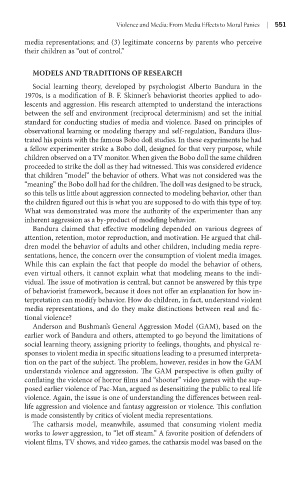Page 572 - Battleground The Media Volume 1 and 2
P. 572
V olence and Med a: From Med a Effects to Moral Pan cs | 1
media representations; and (3) legitimate concerns by parents who perceive
their children as “out of control.”
moDELs anD TraDiTions oF rEsEarCh
Social learning theory, developed by psychologist Alberto Bandura in the
1970s, is a modification of B. F. Skinner’s behaviorist theories applied to ado-
lescents and aggression. His research attempted to understand the interactions
between the self and environment (reciprocal determinism) and set the initial
standard for conducting studies of media and violence. Based on principles of
observational learning or modeling therapy and self-regulation, Bandura illus-
trated his points with the famous Bobo doll studies. In these experiments he had
a fellow experimenter strike a Bobo doll, designed for that very purpose, while
children observed on a TV monitor. When given the Bobo doll the same children
proceeded to strike the doll as they had witnessed. This was considered evidence
that children “model” the behavior of others. What was not considered was the
“meaning” the Bobo doll had for the children. The doll was designed to be struck,
so this tells us little about aggression connected to modeling behavior, other than
the children figured out this is what you are supposed to do with this type of toy.
What was demonstrated was more the authority of the experimenter than any
inherent aggression as a by-product of modeling behavior.
Bandura claimed that effective modeling depended on various degrees of
attention, retention, motor reproduction, and motivation. He argued that chil-
dren model the behavior of adults and other children, including media repre-
sentations, hence, the concern over the consumption of violent media images.
While this can explain the fact that people do model the behavior of others,
even virtual others, it cannot explain what that modeling means to the indi-
vidual. The issue of motivation is central, but cannot be answered by this type
of behaviorist framework, because it does not offer an explanation for how in-
terpretation can modify behavior. How do children, in fact, understand violent
media representations, and do they make distinctions between real and fic-
tional violence?
Anderson and Bushman’s General Aggression Model (GAM), based on the
earlier work of Bandura and others, attempted to go beyond the limitations of
social learning theory, assigning priority to feelings, thoughts, and physical re-
sponses to violent media in specific situations leading to a presumed interpreta-
tion on the part of the subject. The problem, however, resides in how the GAM
understands violence and aggression. The GAM perspective is often guilty of
conflating the violence of horror films and “shooter” video games with the sup-
posed earlier violence of Pac-Man, argued as desensitizing the public to real life
violence. Again, the issue is one of understanding the differences between real-
life aggression and violence and fantasy aggression or violence. This conflation
is made consistently by critics of violent media representations.
The catharsis model, meanwhile, assumed that consuming violent media
works to lower aggression, to “let off steam.” A favorite position of defenders of
violent films, TV shows, and video games, the catharsis model was based on the

